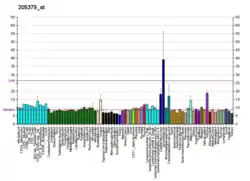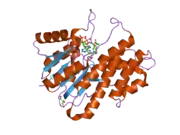CBR3
Carbonyl reductase [NADPH] 3 is an enzyme that in humans is encoded by the CBR3 gene.[5][6][7]
Carbonyl reductase 3 catalyzes the reduction of a large number of biologically and pharmacologically active carbonyl compounds to their corresponding alcohols. The enzyme is classified as a monomeric NADPH-dependent oxidoreductase. CBR3 contains three exons spanning 11.2 kilobases and is closely linked to another carbonyl reductase gene - CBR1.[7]
References
- GRCh38: Ensembl release 89: ENSG00000159231 - Ensembl, May 2017
- GRCm38: Ensembl release 89: ENSMUSG00000022947 - Ensembl, May 2017
- "Human PubMed Reference:". National Center for Biotechnology Information, U.S. National Library of Medicine.
- "Mouse PubMed Reference:". National Center for Biotechnology Information, U.S. National Library of Medicine.
- Watanabe K, Sugawara C, Ono A, Fukuzumi Y, Itakura S, Yamazaki M, Tashiro H, Osoegawa K, Soeda E, Nomura T (May 1999). "Mapping of a novel human carbonyl reductase, CBR3, and ribosomal pseudogenes to human chromosome 21q22.2". Genomics. 52 (1): 95–100. doi:10.1006/geno.1998.5380. PMID 9740676.
- Persson B, Kallberg Y, Bray JE, Bruford E, Dellaporta SL, Favia AD, Duarte RG, Jornvall H, Kavanagh KL, Kedishvili N, Kisiela M, Maser E, Mindnich R, Orchard S, Penning TM, Thornton JM, Adamski J, Oppermann U (Feb 2009). "The SDR (short-chain dehydrogenase/reductase and related enzymes) nomenclature initiative". Chem Biol Interact. 178 (1–3): 94–8. doi:10.1016/j.cbi.2008.10.040. PMC 2896744. PMID 19027726.
- "Entrez Gene: CBR3 carbonyl reductase 3".
External links
- Human CBR3 genome location and CBR3 gene details page in the UCSC Genome Browser.
Further reading
- Wermuth B, Mäder-Heinemann G, Ernst E (1995). "Cloning and expression of carbonyl reductase from rat testis". Eur. J. Biochem. 228 (2): 473–9. doi:10.1111/j.1432-1033.1995.tb20286.x. PMID 7705364.
- Maruyama K, Sugano S (1994). "Oligo-capping: a simple method to replace the cap structure of eukaryotic mRNAs with oligoribonucleotides". Gene. 138 (1–2): 171–4. doi:10.1016/0378-1119(94)90802-8. PMID 8125298.
- Suzuki Y, Yoshitomo-Nakagawa K, Maruyama K, et al. (1997). "Construction and characterization of a full length-enriched and a 5'-end-enriched cDNA library". Gene. 200 (1–2): 149–56. doi:10.1016/S0378-1119(97)00411-3. PMID 9373149.
- Dahmane N, Ghezala GA, Gosset P, et al. (1998). "Transcriptional map of the 2.5-Mb CBR-ERG region of chromosome 21 involved in Down syndrome". Genomics. 48 (1): 12–23. doi:10.1006/geno.1997.5146. PMID 9503011.
- Ismail E, Al-Mulla F, Tsuchida S, et al. (2000). "Carbonyl reductase: a novel metastasis-modulating function". Cancer Res. 60 (5): 1173–6. PMID 10728668.
- Hattori M, Fujiyama A, Taylor TD, et al. (2000). "The DNA sequence of human chromosome 21". Nature. 405 (6784): 311–9. Bibcode:2000Natur.405..311H. doi:10.1038/35012518. PMID 10830953.
- Umemoto M, Yokoyama Y, Sato S, et al. (2001). "Carbonyl reductase as a significant predictor of survival and lymph node metastasis in epithelial ovarian cancer". Br. J. Cancer. 85 (7): 1032–6. doi:10.1038/sj.bjc.6692034. PMC 2375107. PMID 11592776.
- Strausberg RL, Feingold EA, Grouse LH, et al. (2003). "Generation and initial analysis of more than 15,000 full-length human and mouse cDNA sequences". Proc. Natl. Acad. Sci. U.S.A. 99 (26): 16899–903. doi:10.1073/pnas.242603899. PMC 139241. PMID 12477932.
- Gerhard DS, Wagner L, Feingold EA, et al. (2004). "The status, quality, and expansion of the NIH full-length cDNA project: the Mammalian Gene Collection (MGC)". Genome Res. 14 (10B): 2121–7. doi:10.1101/gr.2596504. PMC 528928. PMID 15489334.
- Lakhman SS, Ghosh D, Blanco JG (2005). "Functional significance of a natural allelic variant of human carbonyl reductase 3 (CBR3)". Drug Metab. Dispos. 33 (2): 254–7. doi:10.1124/dmd.104.002006. PMID 15537833. S2CID 18027092.
This article is issued from Wikipedia. The text is licensed under Creative Commons - Attribution - Sharealike. Additional terms may apply for the media files.






